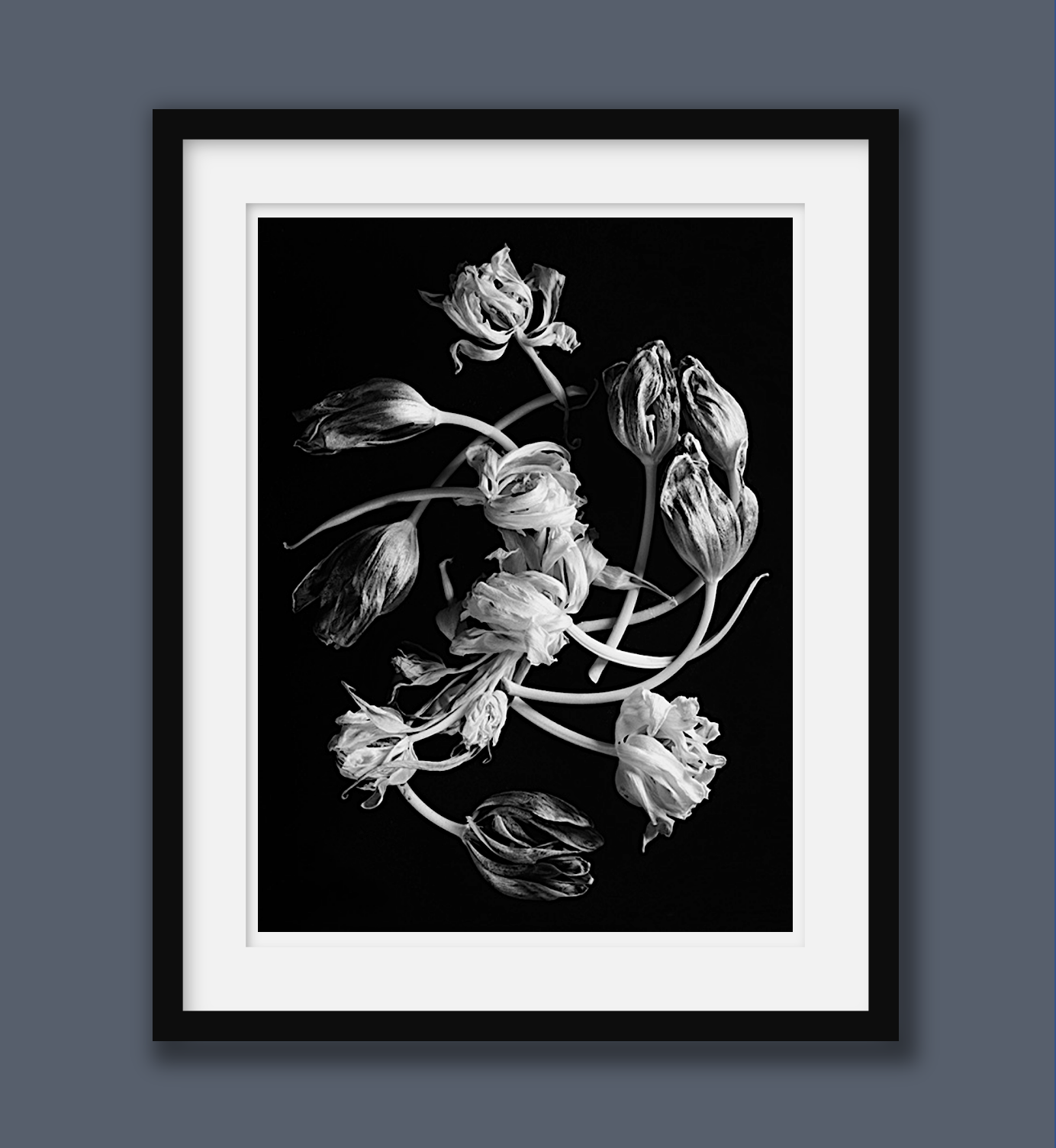

Title: Tulip Constellation Bloom Flowers By Art Photographer Mark Fields
Shipping: $40.00
Artist: N/A
Period: Contemporary
History: Art
Origin: North America > United States
Condition: Museum Quality
Item Date: 2013
Item ID: 6303
Tulip Constellation by artist Mark Fields is a Fine Art Photograph of tulip blooms slightly past their prime evoking nostalgia and emotional yearning. This sensuous, swirling and romantic photograph was shot using a medium format camera, specifically a Mamiya 645 Pro using medium format black and white film. This film size is 3 times that of 35mm film. The film was scanned on an Imacon film scanner, one of the highest end professional film scanners which extracts the highest level digital information. This is an archival pigment print on Exhibition Fine Art Paper made by Epson. The surface of this paper is low gloss with a slight elegant texture reminiscent of a traditional darkroom "Fiber" paper. The print image is pure neutral Black and White. The weight of this paper is a medium heavy weight 325 g/m2 and it is 13ml thick. The print is signed on the back in pencil with artists name, date the image was created and the Edition No. 6 out of an Edition of 30. Actual image size is 12" by 16" on 13" x 19" paper allowing 1/2" blank border on either side and 1 1/2" blank border top and bottom. The print is left unmated giving the owner the ability to have it framed to meet their own vision. My primary technical concern in my flower photographs was the use of light as a way of achieving chiaroscuro, using a timeless technique to illuminate the uniqueness of each flower. One can follow my inspiration in the work of Weston, Mapplethorpe, Blossfeldt and Renger-Patzsch. I establish a "relationship" with the flowers while I am working with them: in time they tell me how to capture them. Each flower has a personality unique as any person, animal or landscape. Their beauty and power come from the "actual exactness" of what they are. Rather than trying to obscure them by imposing photographic techniques that camouflage their precise characteristic, their magnificence comes from showing the geometry, forms, textures as a given. Using the technique of chiaroscuro, which has been used by some of the greatest artists in history as a way of creating drama, my desire is to accentuate exactly what they are, but in a dramatic way.
The history of organic photography—focusing on nature's internal beauty—emerged as fine artists began using the camera not just to document, but to reveal the delicate, often unseen intricacies of the natural world. Beginning with early pioneers like Karl Blossfeldt, who magnified plant structures to highlight their architectural elegance, artists have used photography to bridge science and art. This approach emphasizes patterns, textures, and the life force within natural forms, presenting leaves, roots, shells, and even decay as aesthetic subjects. In the 20th and 21st centuries, contemporary fine artists have continued this tradition, often blending abstraction and environmental themes. Through macro photography, alternative printing techniques, and even bio-reactive processes, these artists celebrate nature’s design while calling attention to ecological fragility. Organic photography becomes a poetic medium—used not just to see nature, but to feel it.
Link: http://en.wikipedia.org/wiki/Fine_art_photography
Fine art photography is photography created in accordance with the vision of the artist as photographer. Fine art photography stands in contrast to representational photography, such as photojournalism, which provides a documentary visual account of specific subjects and events, literally re-presenting objective reality rather than the subjective intent of the photographer; and commercial photography, the primary focus of which is to advertise products or services.One photography historian claimed that "the earliest exponent of 'Fine Art' or composition photography was John Edwin Mayall, "who exhibited daguerrotypes illustrating the Lord's Prayer in 1851".[15] Successful attempts to make fine art photography can be traced to Victorian era practitioners such as Julia Margaret Cameron, Charles Lutwidge Dodgson, and Oscar Gustave Rejlander and others. In the U.S. F. Holland Day, Alfred Stieglitz and Edward Steichen were instrumental in making photography a fine art, and Steiglitz was especially notable in introducing it into museum collections.
In the UK as recently as 1960, photography was not really recognised as a Fine Art. Dr S.D.Jouhar said, when he formed the Photographic Fine Art Association at that time - "At the moment photography is not generally recognized as anything more than a craft. In the USA photography has been openly accepted as Fine Art in certain official quarters. It is shown in galleries and exhibitions as an Art. There is not corresponding recognition in this country. The London Salon shows pictorial photography, but it is not generally understood as an art. Whether a work shows aesthetic qualities or not it is designated 'Pictorial Photography' which is a very ambiguous term. The photographer himself must have confidence in his work and in its dignity and aesthetic value, to force recognition as an Art rather than a Craft"
Until the late 1970s several genres predominated, such as; nudes, portraits, natural landscapes (exemplified by Ansel Adams). Breakthrough 'star' artists in the 1970s and 80s, such as Sally Mann, Robert Mapplethorpe, and Cindy Sherman, still relied heavily on such genres, although seeing them with fresh eyes. Others investigated a snapshot aesthetic approach.
American organizations, such as the Aperture Foundation and the Museum of Modern Art, have done much to keep photography at the forefront of the fine arts.